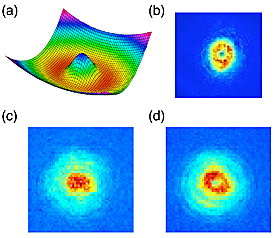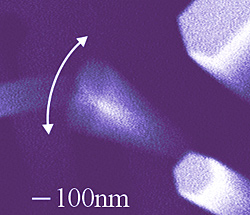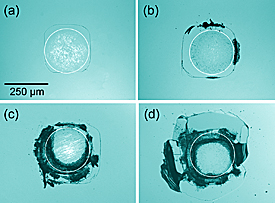| November 27, 2007

[NIST Tech Beat Search] [Credits] [NIST Tech Beat Archives] [Media Contacts] [Subscription Information]

Presidential Award for Excellence Honors Five U.S. Organizations
On November 20, President George W. Bush and Commerce Secretary Carlos M. Gutierrez named five organizations as the recipients of the 2007 Malcolm Baldrige National Quality Award, the nation’s highest Presidential honor for organizational performance excellence. This year the awardees included nonprofit organizations for the first time.
The 2007 Baldrige Award recipients—listed with their category—include:
- PRO-TEC Coating Co., Leipsic, Ohio (small business)
- Mercy Health System, Janesville, Wisc. (health care)
- Sharp HealthCare, San Diego, Calif. (health care)
- City of Coral Springs, Coral Springs, Fla. (nonprofit)
- U.S. Army Armament Research, Development and Engineering Center (ARDEC), Picatinny Arsenal, N.J. (nonprofit)
The Baldrige Award promotes excellence in organizational performance, recognizes the achievements and results of U.S. organizations, and publicizes successful performance strategies. The award is not given for specific products or services. Since 1988, 72 organizations have received Baldrige Awards.
The 2007 honorees were selected from a field of 84 applicants. All of the applicants were evaluated rigorously by an independent board of examiners in seven areas: leadership; strategic planning; customer and market focus; measurement, analysis and knowledge management; workforce focus; process management; and results. The evaluation process for the 2007 recipients included about 1,000 hours of review and an on-site visit by teams of examiners to clarify questions and verify information in the applications.
The newest Baldrige recipients are expected to be presented with their awards in a ceremony in Washington, D.C., early next year.
The Baldrige National Quality Program is managed by the National Institute of Standards and Technology (NIST) in conjunction with the private sector.
For details, see “Presidential Award for Excellence Honors Five U.S. Organizations.” For more information on the Baldrige Program, see www.quality.nist.gov.
Media Contact: Michael E. Newman, michael.newman@nist.gov, (301) 975-3025 

NIST Announces First Observation of ‘Persistent Flow’ in a Gas
 |
(a) In a donut, shaped, or “toroidal” trap, atoms mostly exist in a red ring and do not reside in the center (blue region), which represents an energy hill they cannot climb. (b) Image of a Bose-Einstein condensate (BEC) in the donut trap. (c) When there is no fluid flow around the donut and the trap is turned off, atoms (red) rush to the center. (d) When fluid flows around the donut and the trap is turned off, the current around the donut persists and does not rush to fill the hole.
Credit: NIST
View higher resolution image |
Using laser light to stir an ultracold gas of atoms, researchers at the National Institute of Standards and Technology (NIST) and the Joint Quantum Institute (NIST/University of Maryland) have demonstrated the first “persistent” current in an ultracold atomic gas —a frictionless flow of particles. This relatively long-lived flow, a hallmark of a special property known as “superfluidity,” might help bring to the surface some deep physics insights, and enable super-sensitive rotation sensors that could someday make navigation more precise. The researchers report this feat in an upcoming Physical Review Letters.*
To carry out the demonstration, the researchers first created a Bose-Einstein condensate (BEC), a gas of atoms cooled to such low temperatures that it transforms into matter with unusual properties. One of these properties is superfluidity, the fluid version of superconductivity (whereby electrical currents can flow essentially forever in a loop of wire). Although BECs in principle could support everlasting flows of gas, traditional setups for creating and observing BECs have not provided the most stable environments for the generally unstable superfluid flows, which have tended to break up after short periods of time.
To address this issue, the NIST researchers use laser light and magnetic fields on a gas of sodium atoms to create a donut-shaped BEC—one with a hole in the center—as opposed to the usual ball- or cigar-shaped BEC. This configuration ends up stabilizing circular superfluid flows because it would take too much energy for the hole—containing no atoms—to disturb matters by moving into the donut—which contains lots of atoms.
To stir the superfluid, the researchers zap the gas with laser light that has a property known as orbital angular momentum. (See “‘Tornadoes’ Are Transferred From Light to Sodium Atoms.”) Acting like a boat paddle sweeping water in a circle, the orbital angular momentum creates a fluid flow around the donut. After the stirring, the researchers have observed the gas flowing around the donut for up to 10 seconds. Even more striking, this persistent flow exists even when only 20 percent of the gas atoms were in the special BEC state.
This experiment may provide ways to study the fundamental connection between BECs and superfluids. More practically, the technique may lead to ultraprecise navigation gyroscopes. A BEC superfluid is very sensitive to rotation; its flow would change in fixed steps in response to small changes in rotation. Sound too impractical for airplane navigation? Research groups around the world already have taken the first step by demonstrating BECs on a chip.
* C. Ryu, M. F. Andersen, P. Cladé, V. Natarajan, K. Helmerson and W.D. Phillips, Observation of persistent flow of a Bose-Einstein condensate in a toroidal trap. Physical Review Letters. (forthcoming)
Media Contact: Ben Stein, bstein@nist.gov, (301) 975-3097 

‘High Q’ NIST Nanowires May be Practical Oscillators
 |
Electron micrograph of a NIST-grown nanowire with a high “quality factor” vibrating more than 1 million times per second. At lower right, a stationary nanowire shows the typical hexagonal shape of the gallium nitride structures.
Credit: S. Tanner, CU/JILA
View higher resolution image |
Nanowires grown at the National Institute of Standards and Technology (NIST) have a mechanical “quality factor” at least 10 times higher than reported values for other nanoscale devices such as carbon nanotubes, and comparable to that of commercial quartz crystals. Because a high Q factor indicates a capacity for stable vibrations, the nanowires might be used as oscillators in nano-electromechanical systems for future nano-sensors and communications devices.
“We think the most interesting thing about these wires is the very high quality factor observed for such a small object,” says NIST researcher and co-author Kris Bertness, who grew the nanowires.
NIST has developed a unique way of growing hexagonal gallium nitride (GaN) nanowires featuring low defect density and high luminescence intensity. In a new paper*, researchers at NIST and the University of Colorado at Boulder report high Q factors in wires that are 30 to 500 nanometers in diameter and 5 to 20 micrometers long, vibrating between 400,000 and 2.8 million times per second. (For comparison, the quartz crystals used in watches usually vibrate about 32,000 times a second.) The nanowires vibrated when placed on a piezoelectric device stimulated by an electrical signal. The nanowires also oscillated when excited directly by an electron beam, apparently due to the GaN material’s intrinsic piezoelectric ability to covert voltage to mechanical force.
Q measures the damping of oscillations in a mechanical system as a function of frequency—the higher its Q, the longer a bell rings after being struck. Ordinarily, Q factors of mechanical resonators tend to drop as their diameters shrink. But GaN nanowires have a number of properties that may boost their Q and make them suitable as practical oscillators. They have extremely flat and smooth surfaces (irregularities have reduced performance in other oscillators.) GaN also has a resonant frequency similar to silicon (commonly used in microelectronics) but is less susceptible to some sources of “noise.” Finally, GaN has high heat capacity and thermal conductivity, reducing sensitivity to temperature fluctuations. Another practical advantage is that NIST’s GaN nanowires are grown on silicon, making them compatible with existing microelectronics processing methods.
To measure the resonance properties of the nanowires, researchers observed clumps of nanowires using a scanning electron microscope. As the frequency of the applied signal was varied across a range, the nanowires seen in micrographs appear to blur or fan out at or near the resonance frequency. For the nanowire shown in the image, the Q value (about 38,000) is at least 10 times higher than previously reported values for other GaN nanowires, carbon nanotubes, and single-crystal silicon microstructures of similar surface-to-volume ratio. The researchers have measured Q values of more than 1 million in resonating GaN nanowires using feedback (like continuous striking of a bell to keep it ringing), as would occur in a real device.
* S.M. Tanner, J.M. Gray, C.T. Rogers, K.A. Bertness and N.A. Sanford. 2007. High-Q GaN Nanowire Resonators and Oscillators. Applied Physics Letters. 91, 203117 (2007).
Media Contact: Laura Ost, laura.ost@nist.gov, (303) 497-4880 

NIST Measures Performance of Auto Crash Warning Systems
Engineers at the National Institute of Standards and Technology (NIST) have developed and tested a laser-based ranging system to assess the performance of automobile collision warning systems. Researchers in industry and at the U.S. Department of Transportation (DOT) will be able to use the NIST technology to accelerate the development and commercialization of safety systems that alert drivers to multiple, and sometimes virtually simultaneous potential crash hazards—both from forward or side collisions as well as from running off the road. DOT believes that such warning systems could reduce substantially the number and severity of injuries to motorists and save lives.
Preliminary tests of prototype collision detection systems with the NIST technology have revealed both potential benefits of the systems and areas that need improvement.
According to DOT, of the 3.6 million rear-end, road departure and lane change crashes that occur each year in the United States, 27,500 result in one or more fatalities—about three-quarters of the nation’s yearly auto-related deaths. DOT estimates that widespread deployment of advanced integrated driver assistance systems may reduce such collisions by 48 percent. The department has formed a partnership with the automobile industry called the Integrated Vehicle Based Safety Systems (IVBSS) initiative to hasten deployment of advanced warning systems in the U.S. vehicle fleet.
To evaluate the performance of crash warning systems, which generally use radar, researchers needed an accurate measurement tool based on entirely different principles. NIST researchers developed an independent measurement system (IMS) consisting of a camera and microphone in the cab to detect the driver warning, a suite of calibrated cameras to measure the distance to lane boundaries and laser scanners to measure the distance to obstacles forward and to the side of the vehicle. The system can be mounted on cars or trucks with trailers and requires no modifications or connections to the warning system being tested. The NIST system can detect an object to within about eight-tenths of a meter from up to 60 meters away at speeds up to 25 m/s (within 33 inches at a distance of 197 feet and speeds up to 56 mph.)
NIST used the IMS to evaluate the performance of two systems built by IVBSS industry partners for a light vehicle and a heavy truck. Researchers collected data in representative crash-imminent driving scenarios in which a crash warning should be issued as well as scenarios that might cause a system to issue a false alarm. Both systems passed most of the more than 30 tests conducted this fall in East Liberty, Ohio and Dundee, Mich. However, the IMS revealed some warning system problems in detecting whether forward vehicles were in-lane or out-of-lane on curves or during lane changes. The IMS also measured significant warning delays that resulted in test failures. Such problems are common in automotive crash warning systems that must operate in real-time, at highway speeds, and use multiple low-cost sensors to measure complex three-dimensional scenes.
DOT is currently analyzing the IMS data and if the results indicate the warning systems pass DOT muster, the next step calls for the IVBSS to equip approximately 20 automobiles and 10 trucks with the warning systems. Volunteer motorists and truckers would be asked to use vehicles on the highway for a month. The DOT will analyze the data to refine estimates of benefit if these systems are deployed in most vehicles.
For further information see www.its.dot.gov/ivbss or “Objective Test Scenarios for Integrated Vehicle-based Safety Systems” by John J. Ference, National Highway Traffic Safety Administration; Sandor Szabo, NIST; and Wassim G. Najm, Volpe National Transportation System Center.
Edited Dec. 3, 2007 to update link to publication.
Media Contact: John Blair, john.blair@nist.gov, (301) 975-4261 

Job-Related Stress: NIST Demonstrates Fatigue Effects in Silicon
 |
Optical micrographs of contact damage in silicon from cyclic stress show progressive damage after (a) 1,000 cycles, (b) 5,000 cycles, (c) 20,000 cycles and (d) 85,000 cycles. Color added for clarity, white circle shows computed size of the contact circle.
Credit: NIST
View higher resolution image |
Researchers at the National Institute of Standards and Technology (NIST) have demonstrated a mechanical fatigue process that eventually leads to cracks and breakdown in bulk silicon crystals—a phenomenon that’s particularly interesting because it long has been thought not to exist. Their recently published* results have important implications for the design of new silicon-based micro-electromechanical system (MEMS) devices that have been proposed for a wide variety of uses.
Silicon—the backbone of the semiconductor industry—is one the world’s most heavily studied materials, and it has long been believed to be immune to fatigue from cyclic stresses because of the nature of its crystal structure and chemical bonds. And indeed, conventional tests have validated this. Recent research into silicon MEMS devices, however, has revealed that these microscopic systems that incorporate tiny gears, vibrating reeds and other mechanical features do seem to develop stress-induced cracks that can lead to failure. Why this happens at the microscopic scale is a matter of debate. One school of thought holds that the effect is purely mechanical, due to friction, and the other argues that it essentially is caused by corrosion—a chemical effect. Because the effect has only been noticed at submicrometer scales, it has been difficult to determine which theory is correct.
A material’s resistance to cracking—referred to as “toughness” by materials scientists—is measured customarily by taking a sample of the material, slightly notching one edge, and pulling on the ends repetitively to see if the tensile stress causes the notch to grow into a crack. Bulk silicon always has passed this test. But, argued the NIST team, in real-world MEMS devices the stresses are likely to be much more complicated.
To test this, they used an alternate method: pressing the top of test crystals with tiny tungsten-carbide spheres about 3 mm in diameter at pressures below the silicon’s breaking point. Simply pressing down hard on the crystal for days at a time caused no detectable cracks—arguing against the corrosion theory. On the other hand, using half the pressure but cycling the test hundreds of thousands of times revealed a gradually increasing pattern of surface damage at the indentation site—clear indication of mechanical fatigue. The NIST team, which included a researcher from the University of Extremadura in Spain, theorizes that the critical element in their experiments is the addition of shear stress (causing the crystal planes to slide against each other), a component missing in conventional tensile strength tests but not uncommon in real-world applications.
The NIST experiments demonstrated fatigue effects in silicon at the comparatively large scale of hundred of micrometers. The next step is to determine if the same mechanisms operate at the submicrometer level.
* S. Bhowmick, J.J. Meléndez-Martínez and B.R. Lawn. Bulk silicon is susceptible to fatigue. Applied Physics Letters 91, 201902. Published online 13 November 2007.
Media Contact: Michael Baum, michael.baum@nist.gov, (301) 975-2763 

|

